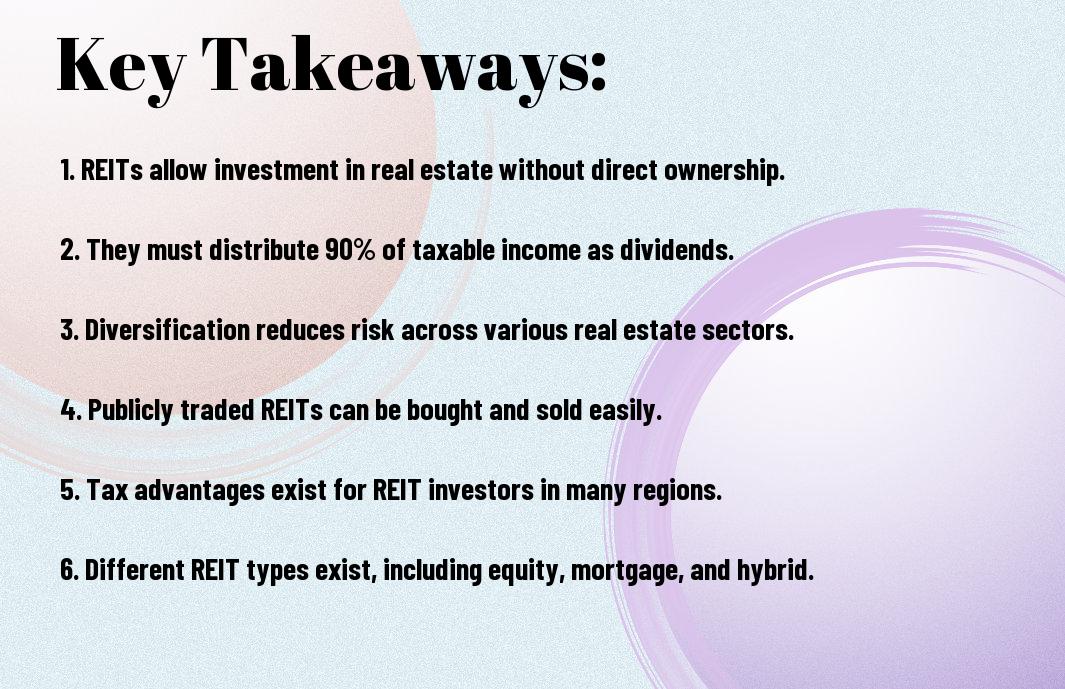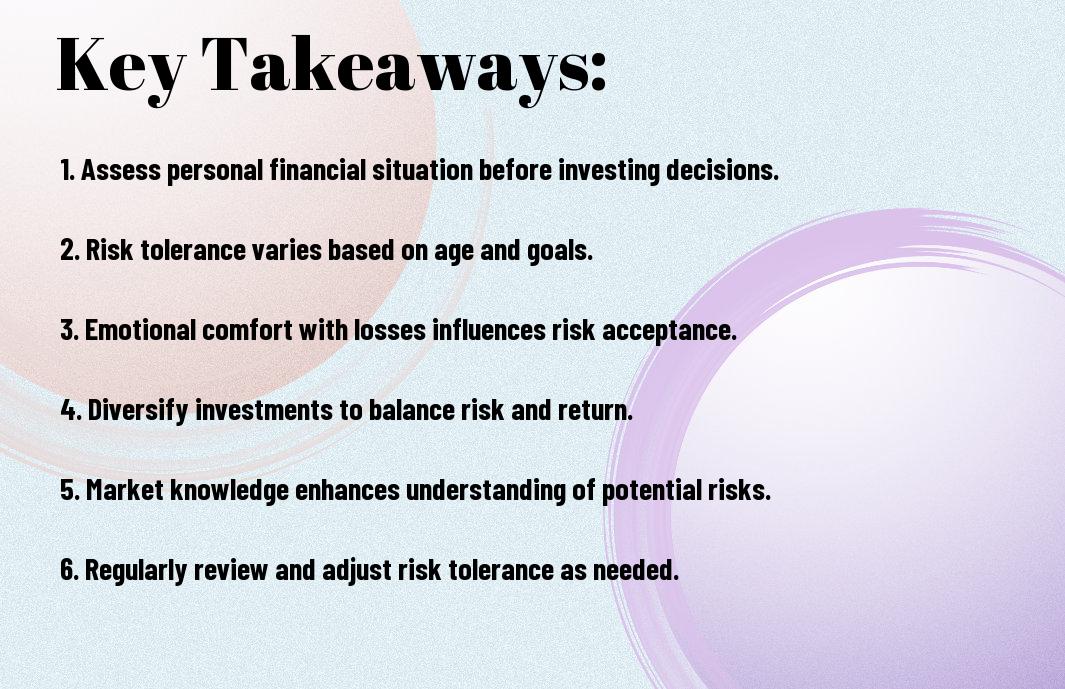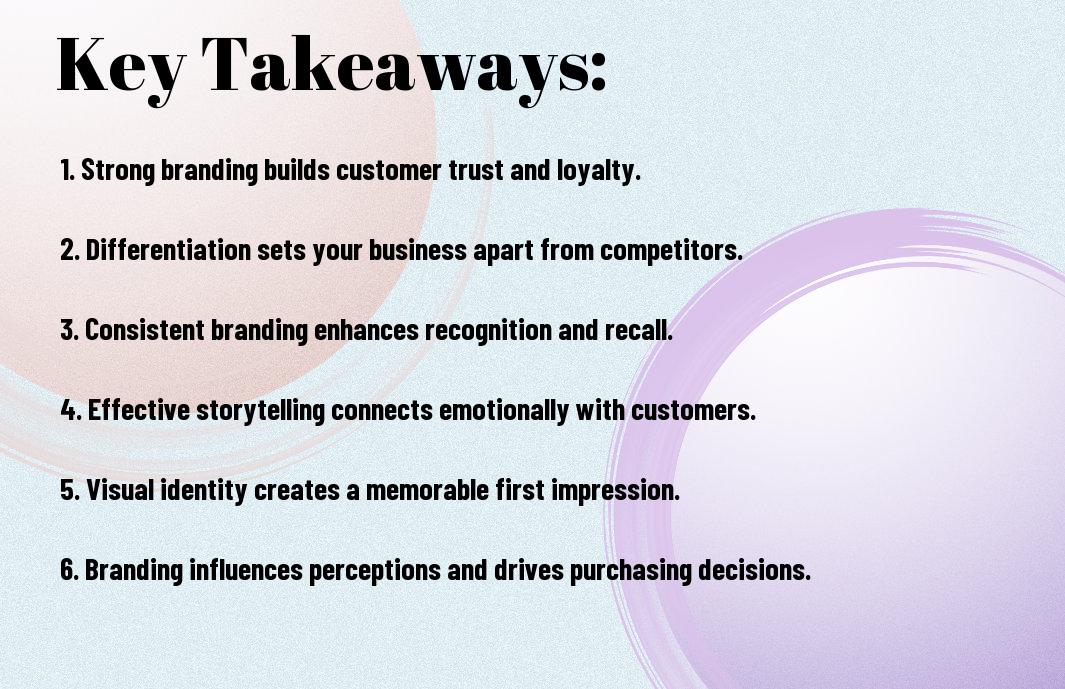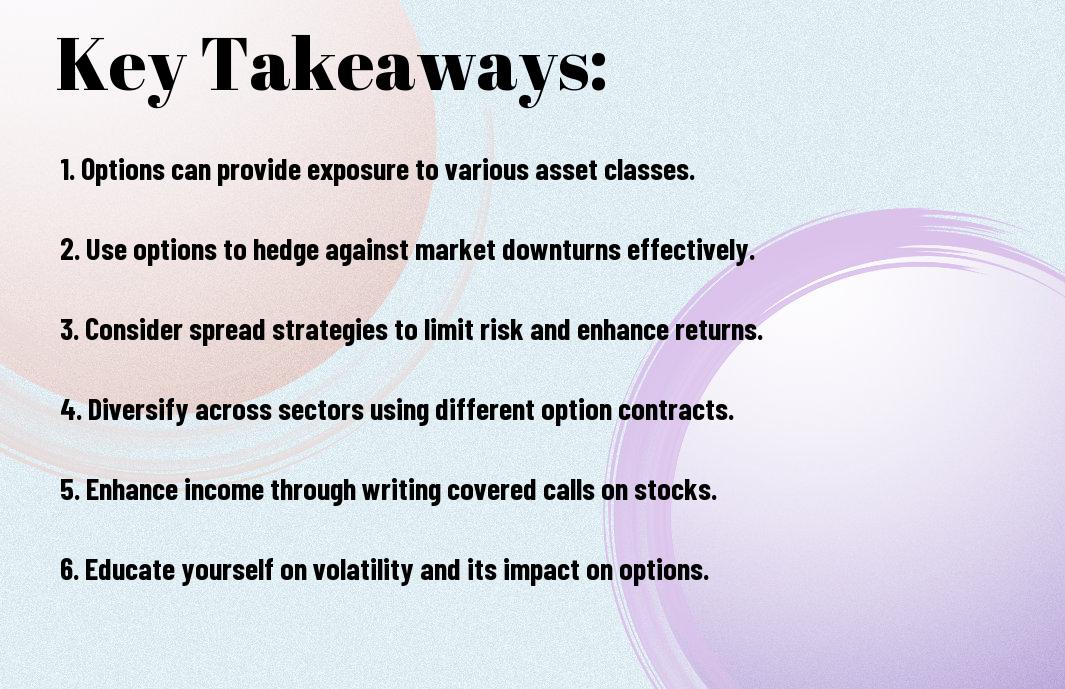Real estate can be a rewarding avenue for building wealth, and one of the most accessible methods for you to invest is through Real Estate Investment Trusts (REITs). These companies own, operate, or finance income-producing real estate, allowing you to invest in real estate without the hassles of direct property management. In this post, you’ll learn the vital concepts behind REITs, their types, and how they can diversify your investment portfolio while potentially providing you with attractive returns.

Key Takeaways:
- Definition: Real Estate Investment Trusts (REITs) are companies that own, operate, or finance income-generating real estate.
- Liquidity: REITs offer liquidity as they are traded on major stock exchanges, allowing investors to buy and sell shares easily.
- Income Generation: They provide a steady income stream, as REITs are required to pay out at least 90% of their taxable income as dividends to shareholders.
- Diversification: Investing in REITs allows individuals to diversify their portfolios without needing to directly purchase properties.
- Types of REITs: There are several types of REITs, including equity REITs, mortgage REITs, and hybrid REITs, each with different investment focuses.

What are Real Estate Investment Trusts (REITs)?
As a savvy investor, understanding Real Estate Investment Trusts (REITs) is important for diversifying your portfolio. REITs are companies that own, operate, or finance income-producing real estate across various property sectors, allowing you to invest in real estate without directly buying properties. By pooling capital from multiple investors, REITs make it accessible for you to earn a share of the income generated through property investments.
Definition and Structure
Against the backdrop of traditional real estate investments, REITs provide a more liquid investment option. They typically operate as publicly traded companies that buy and manage real estate, distributing at least 90% of their taxable income to shareholders in the form of dividends. This structure offers a way for you to invest in real estate without the hassle of property management.
Types of REITs
There are several types of REITs that cater to diverse investment strategies, allowing you to align your goals with the right type of trust. Here’s a breakdown of the main types:
- Equity REITs – primarily own and manage income-producing real estate.
- Mortgage REITs – provide financing for income-producing real estate by purchasing or originating mortgages.
- Hybrid REITs – combine both equity and mortgage REITs.
- Publicly Traded REITs – listed on major stock exchanges, offering liquidity.
- Private REITs – not publicly traded, often available to accredited investors only.
Perceiving these distinctions can help you choose the type of REIT that best suits your investment style and objectives.
| Type of REIT | Key Characteristics |
|---|---|
| Equity REITs | Own and manage properties for rental income and capital appreciation. |
| Mortgage REITs | Invest in mortgages or mortgage-backed securities, earning income from interest. |
| Hybrid REITs | Combine aspects of both equity and mortgage REITs. |
| Publicly Traded REITs | Listed on major stock exchanges, easy to buy and sell. |
| Private REITs | Not publicly traded, typically available to accredited investors. |
About REITs, you can also gain from specialized sectors such as healthcare, data centers, and agricultural land. This diversification can mitigate risks associated with traditional real estate investments. By choosing different sectors, you expand your investment horizons and enhance your portfolio’s potential.
- Healthcare REITs – invest in properties like hospitals and nursing facilities.
- Data Center REITs – focus on properties that house critical IT infrastructure.
- Retail REITs – manage shopping centers and retail properties.
- Industrial REITs – invest in warehouses and distribution facilities.
- Residential REITs – own apartment complexes and single-family homes.
Perceiving the variety of REIT types enables you to make informed investment decisions aligned with your financial aspirations.
| Type of Sector | Focus of Investment |
|---|---|
| Healthcare REITs | Invest in healthcare facilities and senior living. |
| Data Center REITs | Invest in properties that support tech infrastructure. |
| Retail REITs | Focus on shopping centers and retail outlets. |
| Industrial REITs | Specialize in warehouses and industrial space. |
| Residential REITs | Own and manage rental apartment buildings. |
How REITs Work
Clearly, Real Estate Investment Trusts (REITs) operate by pooling capital from numerous investors to purchase, manage, and sell income-producing real estate. This structure allows you to invest in large-scale commercial properties without needing substantial capital. Essentially, when you invest in a REIT, you are buying shares in a company that generates income through property ownership. For a detailed understanding, take a look at this page on Real Estate Investment Trusts (REITs).
Investment Strategies
Beside understanding how REITs function, it is important to explore various investment strategies. Depending on your financial goals, you can choose between equity REITs, which invest directly in properties, and mortgage REITs, which provide financing for income-producing real estate. Your strategy may also include geographic and sector diversification to optimize returns and manage risk effectively.
Revenue Generation and Distribution
To generate revenue, REITs typically lease commercial properties, collect rents, and sometimes sell properties for profit. They are required by law to distribute at least 90% of their taxable income as dividends to shareholders, which allows you to receive consistent income streams. This structure not only incentivizes the management of assets carefully but also keeps you engaged in a rewarding investment experience.
Considering the importance of revenue, REITs carve out a unique niche in your investment portfolio. They not only provide regular income through dividends but also offer potential for capital appreciation. This makes them an attractive option for diversifying your investments while keeping an eye on steady revenue generation. By selecting the right REITs, you can benefit from both the income and appreciation aspects of real estate, making your portfolio more resilient over time.
The Benefits of Investing in REITs
For those looking to diversify their investment portfolio, Real Estate Investment Trusts (REITs) offer a wealth of advantages. They provide you with the opportunity to invest in real estate without the need for direct property management or ownership. REITs enhance liquidity, allow for passive income, and are an accessible means of participating in the real estate market.
Liquidity and Accessibility
The beauty of investing in REITs lies in their liquidity and accessibility. Unlike traditional real estate investments, which require significant capital and time for purchasing and selling properties, REITs can be bought or sold on stock exchanges, providing you with the flexibility you desire.
Income Generation
With REITs, you can enjoy a reliable source of income, as they are required to distribute at least 90% of their taxable income to shareholders as dividends. This feature makes them attractive for income-focused investors seeking regular cash flow.
At the heart of income generation from REITs is their strategy of investing in income-producing properties. Whether it’s residential apartments, commercial offices, or healthcare facilities, these properties generate consistent rental income, which translates into dividend payouts for you. The regular income can enhance your overall financial strategy, making REITs a compelling option for those looking to secure passive income while enjoying the benefits of real estate investment. This structure allows you to enjoy real estate’s potential without having to manage physical properties directly.
Risks Associated with REIT Investments
Once again, while REITs offer a relatively passive investment opportunity, they are not without risks. Factors like market fluctuations, interest rate changes, and management decisions can affect your returns. Understanding these risks is vital for every investor considering entering the REIT market, as it helps you make informed decisions and manage your investment portfolio effectively.
Market Volatility
Volatility in the market can significantly impact your REIT investments. Market downturns can lead to fluctuations in property values and rental income, affecting the overall performance of the REIT. By investing in REITs, you expose your portfolio to these market dynamics. Staying aware of economic trends can help you mitigate potential losses.
Interest Rate Sensitivity
Volatility in interest rates also plays a significant role in your REIT investments. As interest rates rise, the cost of borrowing for REITs increases, potentially impacting their ability to finance new projects or refinance existing debt. This can lead to decreased profitability and lower dividend payouts, which are vital for many REIT investors.
Interest rate fluctuations can create a ripple effect through the REIT sector. Higher rates may make alternative investments, such as bonds, more attractive compared to REITs, leading to a decline in share prices. It is vital for you to monitor interest rate trends and understand how they influence REIT performance, as they can directly affect your investment returns and financial strategy.
How to Invest in REITs
All investing in Real Estate Investment Trusts (REITs) can be achieved through various channels, enabling you to diversify your portfolio with real estate assets without the need for direct property ownership. You can purchase shares of publicly traded REITs on stock exchanges, invest in private or non-traded REITs, or even consider REIT mutual funds and ETFs that pool multiple properties.
Direct Ownership vs. REIT Funds
Between direct ownership of physical real estate and investing in REIT funds, each option presents unique advantages and drawbacks. If you choose direct ownership, you gain complete control over the property but face challenges like maintenance and market fluctuations. In contrast, REIT funds offer a more passive investment approach, allowing you to benefit from real estate appreciation and income without the headaches of property management.
Evaluating REIT Performance
The performance of REITs can be assessed through several key metrics, including funds from operations (FFO), dividend yield, and net asset value (NAV). These indicators help you gauge the income generated and the potential for capital appreciation. Additionally, reviewing historical performance and understanding the underlying property sectors can provide insights into potential risks and rewards.
Direct evaluation of REIT performance should not only focus on financial metrics. You should also consider management quality, market conditions, and property portfolio diversification. By understanding the potential impacts of economic changes on different sectors, you can make informed investment decisions and accurately assess the future profitability of your selected REITs.
Tax Implications of REIT Investments
Not all investments are equal when it comes to taxation, and Real Estate Investment Trusts (REITs) are no exception. Understanding the tax implications of REIT investments can significantly impact your overall returns. For an in-depth look at the nuances, check out the ABCs of REITs.
Tax Treatment of REIT Income
REIT income is generally not taxed at the corporate level, provided the trust distributes at least 90% of its taxable income to shareholders. This distribution requirement allows you to enjoy potentially favorable tax rates on dividends received, rather than facing double taxation often seen in other investment vehicles.
Reporting and Compliance Requirements
REITs must adhere to specific reporting and compliance requirements established by the IRS and other regulatory bodies. You will receive Form 1099-DIV from your REIT at tax time, detailing dividends you’ve received and any capital gains distributions.
This form plays a significant role in how you report your earnings on your tax return. Additionally, many REITs provide a detailed statement about the portion of your distributions that qualify as ordinary income versus capital gains, helping you accurately report and minimize your tax obligations.
To wrap up
The basics of Real Estate Investment Trusts (REITs) offer you a unique avenue to diversify your investment portfolio without the need to directly own property. By allowing you to invest in real estate alongside other investors, REITs provide a way to gain exposure to the real estate market while potentially enjoying dividends and growth. Understanding their structure, types, and benefits can empower you to make informed decisions and enhance your financial strategy. As you consider incorporating REITs into your investments, ensure you evaluate your financial goals and risk tolerance.
FAQ
Q: What are Real Estate Investment Trusts (REITs)?
A: Real Estate Investment Trusts (REITs) are companies that own, operate, or finance income-generating real estate across various property sectors. They provide a way for individual investors to earn a share of the income produced through commercial real estate ownership without actually having to buy, manage, or finance any properties themselves. REITs typically invest in commercial properties such as shopping malls, office buildings, apartments, and hotels, and they are required by law to distribute at least 90% of their taxable income to shareholders as dividends.
Q: How do I invest in REITs?
A: Investing in REITs can be done through several avenues. Individual investors can purchase shares of publicly traded REITs on stock exchanges, similar to buying stocks of companies. There are also non-traded REITs, which are typically available through brokers and require a direct investment. Additionally, some mutual funds and exchange-traded funds (ETFs) specifically focus on REITs, allowing for diversified exposure to the real estate sector. Before investing, it’s important to assess the types of REITs available—equity, mortgage, or hybrid—and consider your financial goals and risk tolerance.
Q: What are the potential risks and benefits of investing in REITs?
A: Investing in REITs comes with both potential benefits and risks. The benefits include the opportunity for regular income through dividends, diversification into real estate without the need to directly own properties, and liquidity for publicly traded REITs, allowing investors to buy and sell shares easily. However, risks can include market volatility, interest rate sensitivity, and management decisions that could impact the performance of the REIT. Additionally, the performance of REITs can be influenced by broader economic conditions, including real estate trends and occupancy rates in their respective sectors.







